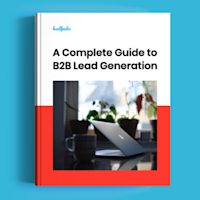Developing a successful B2B sales strategy for lead generation is no easy task.
Identifying the right B2B sales leads can often feel like an uphill climb, requiring careful planning and targeted efforts. If you've explored the world of B2B lead generation strategies, you know that figuring out where to find quality leads is anything but simple. It takes a structured approach, effective tools, and a clear understanding of your target market to succeed in B2B sales.
In the world of B2B sales strategy, you're not just up against savvy buyers and fierce competition; you're also overwhelmed by a flood of misinformation. This includes things like:
👉 Conflicting advice on the most effective methods for generating B2B sales leads. 👉 Overblown case studies from massive corporations that could boost their sales simply by tweeting a photo of their lunch.
It doesn’t make things easier when every expert insists their lead generation strategies are the ultimate solution for securing B2B sales leads. The hard truth is this:
You must customize your approach to fit your organization, industry, product, and target audience. This often requires tuning out the noise of self-promotion and experimenting with different lead gen tactics to find what truly works for you.
The formula is simple: more leads equals more sales. To drive meaningful growth, expanding your lead pipeline is essential.
Ready to begin the search for the ideal B2B sales strategy tailored to your business? Let’s lay a strong foundation to ensure success. In this guide, we’ll explore the essential elements that will set you on the path to effective lead generation, helping you build a B2B sales strategy that delivers real results.
Note: Leadfeeder helps B2B businesses generate more leads by identifying companies that visit your website. Sign up now for a free 14-day trial.
What is B2B lead generation?
B2B lead generation is short for business-to-business lead generation, which describes businesses that primarily sell to (*drumroll please*) other businesses. It serves as the crucial first step in a typical marketing strategy, marketing funnel, or sales process.
Lead gen involves collecting a potential customer’s information — such as name, email, company name, and job title — and using that information to target them with customized sales pitches or ad campaigns.
It's important to note that lead generation for B2B stands apart from business-to-consumer (B2C) lead generation, where products and services are directly marketed to individual consumers. B2B and B2C businesses employ distinct approaches to finding leads, making it crucial to abandon B2C strategies if you seek success in reaching potential B2B customers.
According to Business.com, the three best lead sources for B2B companies are customer referrals, LinkedIn Sales Navigator, and web scraping tools.
B2C, on the other hand, gets more leads from traditional advertising, social media, and email.
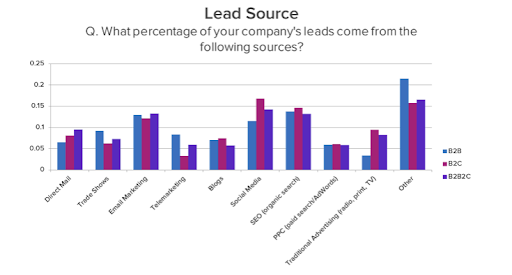
It's not just where leads come from — the nurturing process between B2B and B2C is also quite different, which is why marketers have to start on the right foot.
Who needs a B2B sales strategy?
A B2B sales strategy is essential for any business that sells products or services to other businesses. This includes:
Manufacturers: Companies producing goods for other businesses, such as machinery or raw materials, need a clear sales strategy to identify and reach potential clients.
Software companies: Businesses offering software solutions or platforms to improve operations for other organizations require a strategic approach to demonstrate value and drive adoption.
Consulting firms: Firms providing expert advice and services need to outline how they can meet the specific needs of their clients and differentiate themselves in the market.
Wholesalers and distributors: Companies that supply goods to retailers or other businesses must develop a strategy to manage relationships and optimize their sales processes.
Service providers: Organizations offering specialized services, like marketing, logistics, or IT support, need a strategy to identify target markets and effectively communicate their value proposition.
Startups: New businesses looking to establish themselves in a competitive market must create a focused B2B sales strategy to attract early customers and build a reputation.
Why do you need a B2B sales strategy?
A B2B sales strategy is essential for several reasons:
Targeted approach: It enables businesses to identify and focus on specific target markets, ensuring sales efforts are directed toward the most promising leads.
Improved customer understanding: A well-defined strategy helps sales teams understand the needs, pain points, and decision-making processes of their customers, allowing for more personalized and effective communication.
Consistency: A structured sales strategy ensures that all team members are aligned and follow the same processes, leading to more consistent messaging and improved collaboration.
Enhanced efficiency: A clear strategy streamlines the sales process, reducing time spent on unproductive activities and enabling sales teams to focus on high-impact actions that drive results.
Measurement and adaptation: A B2B sales strategy allows for establishing key performance indicators (KPIs) to track success, analyze performance, and make data-driven adjustments as needed.
Building relationships: It facilitates the development of strong relationships with clients through ongoing engagement and understanding, fostering trust and loyalty over time.
Competitive advantage: A solid sales strategy helps differentiate your business from competitors by clearly articulating your value proposition and addressing customer needs more effectively.
B2B sales strategy examples
Here are some examples of effective B2B sales strategies that businesses can implement to drive sales and foster long-term relationships with their clients:
1. Account-based marketing (ABM)
Example: A software company targets specific high-value accounts by creating personalized marketing campaigns tailored to each account's unique needs and challenges. This approach involves aligning sales and marketing efforts to deliver customized content and outreach, increasing engagement and conversion rates.
2. Content marketing
Example: A consulting firm creates valuable resources, such as whitepapers, case studies, and webinars, to educate potential clients about industry trends and best practices. By positioning themselves as thought leaders, they attract leads and build trust with their audience, ultimately driving sales.
3. Referral programs
Example: A B2B service provider implements a referral program incentivizing existing clients to refer new businesses. They tap into their customer base to generate new leads by offering discounts or rewards for successful referrals.
4. Targeted email campaigns
Example: An e-commerce platform sends targeted email campaigns to segmented lists of potential clients based on their industry and past interactions. These emails offer tailored solutions and highlight relevant case studies, increasing the likelihood of conversions.
5. Social selling
Example: A technology company encourages its sales team to engage with prospects on LinkedIn by sharing insightful content, participating in discussions, and building relationships. This approach helps establish credibility and opens doors for direct sales conversations.
6. Partnerships and alliances
Example: A logistics company partners with a manufacturing firm to offer bundled services. By leveraging each other's strengths, they create a comprehensive solution for clients, increasing their market reach and sales opportunities.
7. Lead nurturing programs
Example: A marketing agency uses automated lead nurturing campaigns to stay in touch with potential clients over time. They gradually guide leads through the sales funnel by providing ongoing value through educational content and timely follow-ups.
8. Free trials or demonstrations
Example: A SaaS company offers free trials or live demos of its software to potential clients. This hands-on approach lets prospects experience the product's value firsthand, making them more likely to convert to paying customers.
9. Customer feedback and testimonials
Example: A manufacturing company actively solicits feedback from existing customers and showcases positive testimonials on its website and in marketing materials. This builds credibility and reassures potential clients about the quality of their offerings.
10. Trade shows and industry events
Example: A B2B company participates in trade shows and industry conferences to showcase its products and services. These events provide opportunities for networking, lead generation, and face-to-face interactions with potential clients.
How to develop a successful B2B sales strategy in 9 steps
Developing a successful B2B sales strategy involves several key steps that align your sales processes with your business goals and target audience. Here’s a comprehensive approach to creating an effective B2B sales strategy:
1. Understand your target market
Define your Ideal Customer Profile (ICP): Identify the characteristics of your best customers, including industry, company size, location, and pain points.
Conduct market research: Gather insights into market trends, competitors, and customer needs to inform your strategy.
2. Set clear goals
Establish specific objectives: Define measurable sales targets (e.g., revenue goals, number of new customers, or conversion rates) to provide direction and motivation for your sales team.
Align with overall business goals: Ensure your sales objectives support the organization's broader goals.
3. Create a compelling value proposition
Identify unique selling points (USPs): Determine what differentiates your product or service from competitors and articulate the value it brings to customers.
Tailor messaging: Develop messaging that resonates with your target audience, addressing their needs and pain points.
4. Develop a multi-channel approach
Choose sales channels: Decide which channels (e.g., direct sales, partnerships, online marketing) will be most effective for reaching your audience.
Integrate marketing efforts: Collaborate with marketing to align strategies, ensuring consistent messaging and brand presence across all channels.
5. Build a strong sales team
Recruit the right talent: Hire sales professionals with the skills and experience to engage effectively with your target market.
Provide ongoing training: Invest in continuous training to inform your team about product updates, industry trends, and B2B sales techniques.
6. Implement a sales process
Map out the sales funnel: Clearly define each stage of the sales process, from lead generation to closing deals, and identify key activities for each stage.
Use CRM tools: Implement customer relationship management (CRM) software to track interactions, manage leads, and analyze sales data.
7. Leverage technology and automation
Adopt sales enablement tools: Utilize tools that provide resources, content, and analytics to support your sales team and improve efficiency.
Automate repetitive tasks: Use automation to handle routine tasks such as follow-up emails and appointment scheduling, allowing your team to focus on building relationships.
8. Monitor and optimize performance
Track key metrics: Measure performance through metrics like conversion rates, average deal size, and sales cycle length to evaluate the effectiveness of your strategy.
Gather feedback and adjust: Regularly seek feedback from your sales team and customers to identify areas for improvement and adapt your strategy accordingly.
9. Nurture relationships
Build long-term partnerships: Focus on nurturing relationships with prospects and existing customers through regular communication and support.
Implement account-based marketing (ABM): Personalize your approach for high-value accounts, tailoring your outreach and solutions to meet their needs.
How to get sales leads
Mastering the art of acquiring B2B sales leads is merely the initial step in a larger process. To truly drive sales growth, you must establish an effective lead-generation process. This process serves as the vital link that aligns marketing and sales teams, providing representatives with a proven framework to follow.
If you’re serious about increasing sales, you’ll need an intense lead generation process. Processes align marketing and sales teams and give reps a proven framework to follow.
Generating business-to-business leads involves a series of carefully orchestrated steps undertaken by salespeople and marketing teams to transform prospects into paying customers. But what exactly do these steps entail? Let's delve into this process to uncover the key components that pave the way to B2B sales success.

Step 1: Find B2B sales leads
The first step in most B2B lead generation strategies is finding the contact information of potential buyers. (Luckily, that’s what we’re covering 😏)
Contact information is often sourced in-house, generated by a third-party “lead gen” company, or bought from a B2B lead database (not advisable for B2B lead generation).
Step 2: Reaching out to leads
With a list of high-quality leads that meet all the criteria of your lead scoring system, reps reach out to them through cold outreach (cold calls or emails), social media, other outbound strategies, or by replying to inquiries.
Step 3: Qualifying & prospecting high-quality leads
While interacting with leads, reps measure how likely leads are to buy.
They’ll do this by gauging the stage at which leads are during the buying process. These stages include:
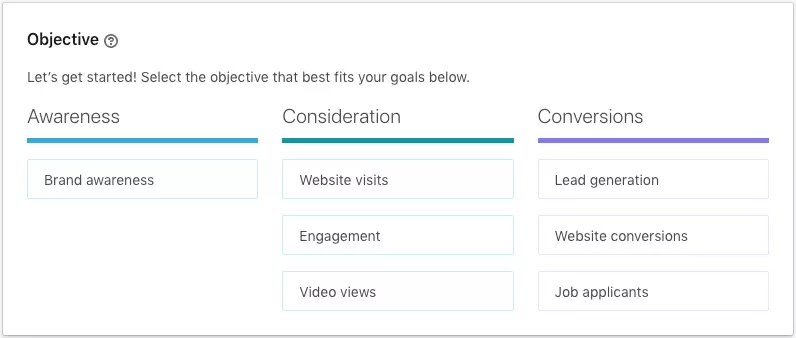
1. Research & awareness: The prospective customer is aware of a solution they need or a problem they face, and they begin to learn more about it.
The awareness stage is where they’ll consume content like blogs, whitepapers, and case studies.
2. Consideration: The lead knows the exact service/product that’s needed. They’ll detail their specific needs before researching and “opening up” to vendors.
3. Decision: Filtering through vendors that best suit their needs, the buyer will have multiple meetings and check in with other decision-makers to complete a purchase.
Depending on what stage a lead is at, reps will initiate nurturing campaigns or focus on getting the prospect to book a call or demo.
Step 4: Close leads by making a sale
Success! After multiple meetings with different vendors, the prospect picks you, and the deal is done. They’ll now be transferred to customer success for onboarding. Woot!
20 B2B sales strategies for 2026 that actually work
The best way to generate more sales is to customize your lead generation strategy according to your industry, product, and target buyers. This is precisely why offering just one or two B2B lead generation strategies wouldn't suffice.
For success, your sales and marketing teams must embrace a mindset of experimentation, continuous learning, and implementation of novel approaches to acquiring B2B sales leads. This entails exploring and testing multiple strategies until you discover what truly works for your unique business.
If you're ready to venture into uncharted territory and explore fresh possibilities, we've compiled a collection of 20 B2B lead generation strategies for you to test. These strategies are designed to inspire innovation and help you uncover new avenues to drive sales growth. It's time to break free from the status quo and embark on a journey of discovery.
1. Run A/B tests on key pages
With thousands of website visitors browsing their site for office wallpapers, WallMonkeys used a heat map tool to see where visitors' eyes landed first on their website. After receiving the results, the WallMonkey team was confident that they could increase B2B sales leads by tweaking their homepage.
Putting their theory to the test, they split-tested a new background image and search bar and boosted the conversion rate by 550 percent. Not too shabby.
Will changing your landing page image increase conversions?
Will a homepage redesign convert more visitors into leads?
A/B split testing is the only way to find out.
2. Use content campaigns to generate B2B sales leads
With less than 100 monthly searches for its target keyword, Snack Nation, an office snack supplier, struggled to increase B2B sales leads through its SEO efforts.
Going after a bigger audience that would include their ideal leads for B2B, they created an epic post on “employee wellness” — a broader search term that their target buyers use.
While producing the post, they took extra care to ensure that it was actually “epic” enough to generate leads.
Results of the “employee wellness” post:
Snack Nation outdid competitors by featuring 121 ideas on “employee wellness.”
They included a large number of contributions from other authorities in the industry.
They also utilized an aggressive outreach strategy to get influencers to share their posts.
The post propelled Snack Nation to the # 1 spot on Google for their keyword.
Despite being over three years old, this post generates tons of traffic and leads for them to this day.

As Snack Nation’s story shows, evergreen content can lead to evergreen B2B lead generation.
So if you can create content that outperforms your competitors, do it.
3. Earn your buyers' trust with social proof
Social proof is a powerful part of most B2B lead generation strategies.
Because buyers may doubt claims about your product/service, they’ll look for testimonials to make a more thoughtful purchasing decision.
The more social proof you can gather on your site, the easier it is to build trust and increase sales.
Consider adding social proof to your landing pages and homepage, sharing reviews on social media, and creating case studies — collecting positive reviews on G2 is another excellent way to build trust.
4. Build a free tool to generate B2B sales leads
HubSpot offers a free CRM.
Crazy Egg provides a free Heatmap tool.
Ubersuggest offers free SEO analytics reports.
Notice a pattern?
For SaaS and tech companies, one of the best B2B lead generation strategies I’ve witnessed is a free tool.
When looking for how to generate B2B leads, a free tool works because:
It allows leads to “try before they buy.”
It gives you a solid opt-in offer that attracts high-quality leads into your sales funnel.
In our early days, we used this exact tactic at Leadfeeder to get users to find and refer leads to us. It’s worked so well that we still offer free trials today!
Also, here, you can check 11 steps to set up a lead generation strategy for your tech company.
5. Use Quora Q&As to generate more B2B sales leads
Using content to educate buyers and answer burning questions is nothing new.
The challenge that most B2B marketers face is:
Getting content in front of buyers.
And finding questions that buyers are asking.
Quora (or other forums) solves both of these problems.
As a social Q&A site, Quora is an underestimated platform for B2B lead generation.
Writer Nicolas Cole, for example, built a loyal following and a solid reputation on Quora by answering questions with detailed and occasionally personal answers.
Thanks to his answers on Quora, he skyrocketed the growth of his 7-figure content agency, Digital Press, within a few years.
Find your buyers on Quora, answer their questions, link back to your content, and profit.
6. Use Leadfeeder to power up B2B social sales
AlertOps was struggling to identify the company visiting their website. They knew that “warm” leads were leaving without giving contact information.
Integrating Leadfeeder into their sales process helped them identify which companies visited their site — even if they didn't download a lead magnet or fill out a form.
Within a month, they boosted their sales demo rates by 700 percent. They even landed a sales demo with a Fortune 500 company. 💪🏼
“Leadfeeder plays a huge role in the [sales] system we built to qualify sales leads and schedule demo calls,” says Nathan Rofkahr, Director of Growth for AlertOps.
7. Publish and promote more case studies
Case studies should be an important part of your content marketing strategy. B2B buyers are highly analytical, risk-averse, and often need the approval of multiple ROI-minded decision-makers before purchasing.
And — as many buyers have admitted — this makes case studies crucial sales enablement content for the middle-to-end stages of the lead generation process.
Don’t just let case studies sit idle on your website. Promote them to skyrocket your credibility.
8. Publish original research to generate sales from savvy buyers
When High-Speed Training published an in-depth report for buyers in the hospitality industry, they saw massive ROI.
Not only did the report position them as the leader in their field, but it also boosted their site’s visibility and earned coverage from 38 different media outlets.
On average, B2B buyers encounter 13 content pieces before purchasing. Content includes information on a vendor’s website, in-depth reports, and third-party reviews.
You can use this reverence for data to radically transform your inbound lead generation. How?
Become a source for industry-related information, trends, and data. Thought leadership will help you:
Become a respected authority in your industry.
Generate strong SEO backlinks and PR coverage.
Deliver value to your potential leads.
9. Generate quick wins from landing page tweaks
Everybody loves ripe, low-hanging fruit.
When it comes to increasing B2B sales, your landing pages — the most transformative points in the buyer journey — are bountiful trees to source fruit.
Get quick B2B lead generation wins on your landing page by following these steps:
Back up your copy with social proof (say it louder for the people in the back 📢).
Make your call-to-action (CTA) copy more relevant.
Upgrade your headline to catch the attention of buyers.
Use a live chat functionality on your page to educate and overcome objections.
10. Personalize your website with dynamic web pages
Website personalization is no longer a bonus in B2B lead generation strategies. It’s a must.
To personalize the buying experience on your site, use dynamic pages and content that adapt to your visitors:
Name
Location
Industry
Company
ABM efforts add an intimate touch to the buyer's journey that creates a powerfully personal experience.
11. Create hard-hitting lead magnets and incentives
Lead magnets are the bread to your B2B lead-generating butter.
Richard Wood, Managing Director at Six & Flow, describes it as, "A lead magnet is anything that you can offer a prospect that has enough perceived value in exchange for their contact information, like an email address. If you want to create an effective lead magnet, you need to focus on your buyer personas and a specific challenge that they have and that you can address."
But most companies get the whole lead magnet thing wrong. They offer surface-level content that’s already available on a typical blog post. That’s not really “magnetic,” is it?
Don’t make the same mistake.
Unless you’re confident it’s valuable, scrap the high-level content and instead share your detailed, real-world experience in the format of:
In-depth guides
Comprehensive how-tos
Detailed case studies
Resource libraries
Workbooks or checklists
Templates
12. Cater to a visual B2B audience with in-depth YouTube videos
If you aren’t using videos in your lead generation campaigns, here are two reasons why you should:
Ninety percent of marketers agree that video is the best way to repurpose B2B content.
YouTube is also the second-largest search engine on the web.
The math is both easy and appealing:
You don’t need blockbuster videos. You can simply turn your existing content into informative videos that generate leads, just like I did with the example below.
We wrote a guide on selling with video, which prompted the panel discussion — who doesn’t love a theme?
"As humans, we are all drawn to video because of the connections that video allows us to make with buyers. And when we can do that we win more business."
- Robert Weiss, President at MultiVision Digital
13. Experiment with creative outreach
Ash Amibirge, a copywriter at The Middle Finger Project, got a 100 percent response rate by mailing physical roofing shingles to her prospects.
Sales rep Jeremy Leveille rapped a B2B song in his email campaigns to get replies from his leads.
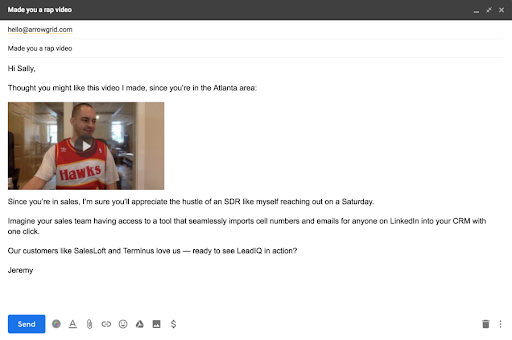
With your competitors sticking to boring cold email scripts, a little bit of creativity in your outreach will go a long way with your B2B lead generation efforts. We’ve recently written about the top creative lead generation ideas with examples. Feel free to check them out for inspiration! 😉
14. Target high-value leads on LinkedIn
LinkedIn is the place to be for “big deal,” high-value B2B lead generation. Using advertising on the platform:
Templafy generated 25 marketing-qualified leads in a week with a 475 percent ROI.
Reed Exhibitions generated 20 percent of all revenue for its SNSR risk and security expo.
Matmatch grew its sales pipeline of suppliers 10x for its engineering materials platform.
While competition is rife and cost-per-click is higher than other platforms, the tradeoff is the ability to hyper-target your audience.
If you’re going to advertise on LinkedIn, make sure you offer:
A premium B2B product or service. Larger lifetime value (LTV) usually allows for the large budget you need to play on LinkedIn.
Unique, high-level education. LinkedIn members are known for being career and skill-minded. If you’re offering content that will help them, you’re likely to see better returns from your ads.
15. Experiment with alternative social media platforms
Robin, a workplace platform, took a risk by directing their lead generation towards platforms where it’s tougher to find B2B leads — and it paid off.
Instead of doubling down on conventional channels like LinkedIn or Twitter, they posted user-generated content on Instagram and Pinterest.
To Robin’s surprise, it paid off. The company’s web traffic increased by 50 percent and brought 20 percent more leads to their door.
As Robin’s story shows, even if you’re B2B, that doesn’t mean you can't generate sales from B2C social channels.
Don't be afraid to test out new and growing platforms. The success of TikTok demonstrates the huge rewards that can be gained from finding a diamond in the rough and taking a chance.
16. Cast a wider B2B lead generation “net” with guest posts
There’s a reason why Inbound lead generation pros like Hubspot still use guest posting to increase B2B sales:
It’s an underused (and misunderstood) strategy that works.
According to a survey by Aira, 42 percent of digital marketers they polled use guest posting:

Even though it has a controversial past, guest posting is still the number one link-building strategy that SEOs recommend.
To enhance your overall search engine optimization and present yourself as an authority to a fresh audience of new B2B leads, guest posting is far from “dead.”
17. Cater to new B2B buyers on mobile
As mobile traffic continues to grow, optimizing for mobile is becoming an increasingly important part of an effective B2B lead generation strategy.
According to DemandGenReport::
91% of B2B buyer searches occur on a mobile device.
74% of B2B buyers research half or more of their purchases online before making a decision.
They also found that B2B marketers already optimizing for mobile are experiencing “reduced purchasing time and higher customer loyalty.”
Given that it takes seconds to check your site’s compatibility with mobile devices, there’s no excuse for not being mobile-friendly.
18. Optimize for long-tail keywords to get more sales-qualified leads
A long-tail keyword is three or more words long and is very specific. And yes, it usually gets a very low search volume.
But target the right long-tail keyword, and you trade off search volume for extremely high purchase intent that increases sales with very little SEO effort.
19. Run campaigns based on competitor keywords
If your competitors flock to certain sites for backlinks or seem to favor optimizing a noticeable group of keywords, that’s a pretty big deal.
It means they’ve found winning keywords that generate leads.
Using SEO research tools like Ahrefs and SEMrush, you can take advantage of this by targeting the same sites and keywords to drive more sales-ready traffic to your site.
A quick tip: Before you spend time and money optimizing for a particular keyword, run a small paid ads campaign to see if it actually attracts and converts your ideal B2B leads.
20. Organize webinars to capture new leads
One of the lead generation strategies is to organize webinars for lead capture. A webinar is an online presentation that's intended to engage customers, educate them on your products or services, talk about pain points, build trust, and increase your brand awareness. It's a great way to reach out to potential clients and build relationships with them before they've even signed up for your product.
In addition to reaching out to potential clients, webinars are also an excellent way to attract new leads. If you're looking for ways to generate more sales leads without paying for advertising, consider hosting a live webinar with a special offer or discount code for your product.
You can also invite other businesses/startups who would benefit from your product or service as guests on your webinar — this will increase awareness about your business and drive traffic back toward it after the event ends!
Remember, if you treat webinars as one of your marketing campaigns, the most important is to give valuable content to your target audience and your ideal customer.
What are the most important B2B sales metrics?
Here are some of the most important B2B sales metrics to track for evaluating sales performance and effectiveness:
Conversion rate: This metric measures the percentage of leads that turn into customers, helping assess the effectiveness of your sales process.
Average deal size: Understanding the average revenue generated per closed deal allows for better forecasting and resource allocation.
Sales cycle length: This metric tracks the average time it takes to close a deal from the initial contact to the final sale, providing insights into sales efficiency.
Customer Acquisition Cost (CAC): This measures the total cost associated with acquiring a new customer, including marketing and sales expenses, helping assess the return on investment.
Customer Lifetime Value (CLV): CLV estimates the total revenue a customer will generate throughout their relationship with your business, providing insights into the long-term value of your customer base.
Lead response time: This metric measures how quickly sales teams respond to incoming leads, which can significantly impact conversion rates.
Sales pipeline velocity: This indicates how quickly deals move through the sales pipeline, providing insights into overall sales efficiency and forecasting.
Win rate: The percentage of deals won compared to the total number of opportunities, helping to assess the effectiveness of your sales tactics.
Churn rate: This metric tracks the percentage of customers lost over a specific period, highlighting customer satisfaction and retention efforts.
Sales activity metrics: Tracking activities such as calls made, emails sent, and meetings scheduled helps assess the productivity of sales representatives.
B2B lead generation tools to grow sales pipeline
As any sales rep will tell you, the more time you can devote to making sales, the more sales you'll make. Shocking revelation, we know. 🤯
Unfortunately, reps usually find themselves sinking in a quicksand of increasingly time-consuming manual tasks.
In fact, research shows that they only spend 28% of their week actually selling.
Emails, prospecting leads, data entry, and meetings eat up most of their working hours.
With the right B2B lead generation tool, reps can automate manual tasks and spend more time closing leads.
While there are a ton of sales tools on the market, listed below are the bare-bones essentials to beef up the entire B2B lead generation process:
Lead generation tool #1: Leadfeeder

The tracking information is enriched with the contact info of employees from the visiting company. You can follow up with buyers during the research phase, kickstart social selling campaigns, or time your outreach perfectly — all with behind-the-scenes insight that you wouldn’t otherwise have access to.
Lead generation tool #2: HubSpot Sales Hub

From email templates, follow-up marketing automation, and scheduling to automated data entry, Sales Hub is designed with salesforce productivity in mind.
Lead generation tool #3: Reply.io
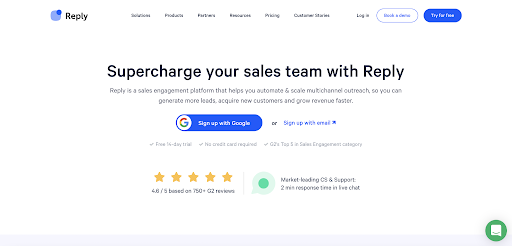
Reply.io helps you find prospect emails on LinkedIn in a few seconds. You can also automate LinkedIn email searches, personal email outreach, calls, and tasks.
Lead generation tool #4: Dealfront Target
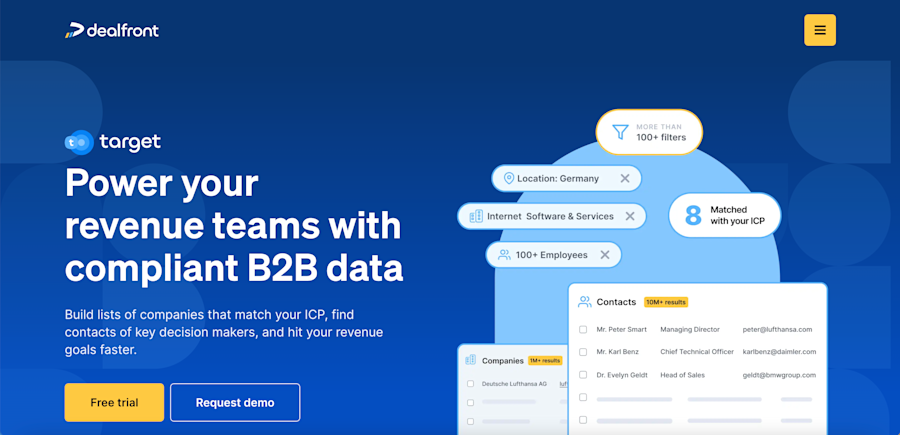
Dealfront Target is a B2B sales prospecting tool that helps customers create company and lead lists and find contact details of key decision-makers. Target offers unique filtering options that go far beyond the standard of just company address, location, and number of employees.
With Target, companies in any industry can boost their prospecting, market analysis, and B2B lead generation. Thanks to Target, our customers ensure they are exclusively targeting companies that fit their ICP.
Lead generation tool #5: Bombora
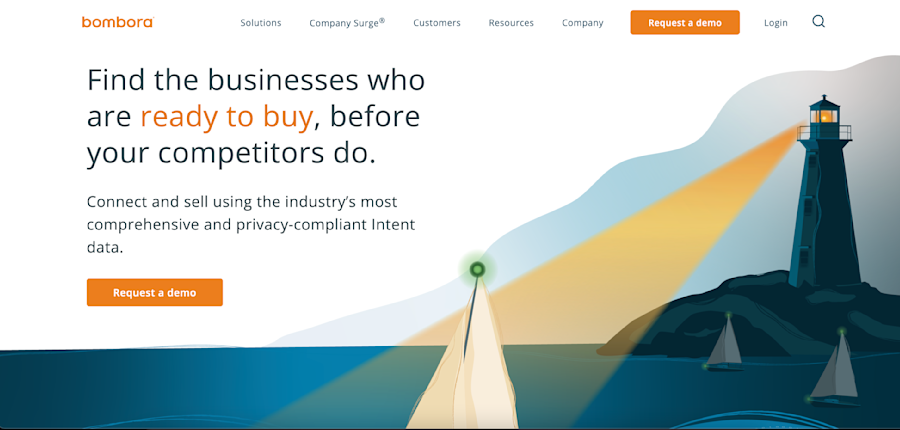
Bombora analyzes content consumption by millions of companies to show the topics your leads are searching for.
It’s a great lead generation tool to help you catch B2B leads during their research phase.
I’ll repeat: This is a bare-bones list that will help you increase B2B leads, regardless of the lead generation tactics for B2B you use. Check out this lead generation tools post for advanced recommendations.
Trends in B2B sales to watch in 2026
As we approach 2026, the B2B sales landscape is set for significant transformation due to evolving technologies and changing buyer preferences. Companies must stay informed of these trends to remain competitive and effectively engage their audiences. Key trends, including increased automation, personalized experiences, and a focus on sustainability, will be crucial for enhancing sales strategies and driving growth. Here are the key B2B sales trends to watch in 2026.
1. Increased automation
More businesses will adopt automated sales processes, using AI and machine learning to streamline lead generation, nurturing, and follow-up, improving efficiency and reducing manual tasks.
2. Personalization
B2B sales strategies will increasingly focus on delivering personalized experiences for prospects, utilizing data analytics to tailor communication and solutions to individual customer needs.
3. ABM
ABM will gain further traction as companies recognize its effectiveness in targeting high-value accounts through customized marketing and sales efforts.
4. Remote selling
The shift to remote work is expected to persist, leading to the continued growth of virtual selling techniques, including video calls and digital presentations, as businesses adapt to remote buyer preferences.
5. Data-driven decision-making
Organizations will rely more heavily on data analytics to inform their sales strategies, enabling them to make informed decisions about targeting, messaging, and resource allocation.
6. Collaborative selling
Teams will increasingly work collaboratively across departments (sales, marketing, and customer success) to create a unified approach to engaging customers and closing deals.
7. Emphasis on customer experience
The focus will shift toward delivering exceptional customer experiences throughout sales, prioritizing relationship building and customer satisfaction to foster loyalty.
8. Sustainability and social responsibility
B2B buyers will increasingly consider sustainability and ethical practices when choosing suppliers, prompting businesses to align their sales strategies with these values.
9. Integration of technology
The use of advanced sales technologies, including CRM systems, chatbots, and predictive analytics, will continue to evolve, helping sales teams improve efficiency and effectiveness.
10. Continued growth of e-commerce
B2B e-commerce platforms will expand, offering seamless online purchasing experiences and making it easier for businesses to procure goods and services digitally.
B2B sales strategy tips
Here are some effective tips to enhance your B2B sales strategy and drive success:
1. Understand your target market
Research and define your ideal customer profile to tailor your approach and messaging effectively.
2. Build strong relationships
Focus on developing long-term relationships with prospects by engaging with them genuinely and consistently.
3. Leverage social selling
Utilize platforms like LinkedIn to connect with potential clients, share valuable content, and establish your authority in the industry.
4. Personalize your outreach
Customize your communication based on the prospect’s needs and pain points to demonstrate that you understand their challenges.
5. Use data and analytics
Analyze customer data to identify trends, track performance, and make informed decisions that optimize your sales approach.
6. Prioritize follow-ups
Develop a systematic follow-up process to stay engaged with leads and nurture relationships over time.
7. Offer value early
To build trust and credibility, provide valuable resources, such as whitepapers or case studies, to prospects before asking for a sale.
8. Master the art of listening
Listen to your prospects during conversations to better understand their needs and tailor your solutions accordingly.
9. Invest in sales training
Provide ongoing training and development for your sales team to enhance their skills and update them on industry trends.
10. Use technology
Implement CRM tools and sales automation software to streamline processes, track leads, and enhance efficiency.
Unlocking B2B sales strategy: Reach your business customers with a strategy that works for you
Unlocking the secrets to effective B2B sales strategy is crucial for overcoming challenges and driving sales growth. Although it might appear challenging, developing a successful B2B sales strategy is entirely achievable. With the right approach and dedication, you can navigate the complexities of lead generation and set your business on a path to success.
B2B sales strategy and tactics can feel incredibly daunting, prompting you to ask critical questions such as:
👉 Which B2B sales strategy is genuinely the most effective? 👉 Will this particular tactic drive sales growth? 👉 What approach is likely to produce the best results?
Here’s my recommendation: pause and take a moment to reflect.
Overanalyzing and overly fine-tuning your B2B sales strategy may not lead to the outcomes you’re hoping for. Instead, bring your team together to brainstorm and identify promising strategies and tactics, then take decisive action.
The focus should be on finding what works best for your unique situation, eliminating what doesn’t, and driving sales growth without losing opportunities.
Concentrate on the following key areas:
👉 Determine where your buyers congregate and interact. 👉 Identify the sources they trust for research and information. 👉 Discover the factors influencing their purchasing decisions. 👉 Address their main concerns and pain points.
By collecting this crucial information, you can effectively identify the B2B sales strategy that aligns with the needs of both your business and your customers, ultimately driving impactful results.
Contact us today to see how Leadfeeder can help your B2B sales strategy.
FAQs about B2B sales strategy
What is B2B sales?
B2B sales, or business-to-business sales, involves transactions where one business sells products or services to another business rather than to individual consumers. This type of sales typically focuses on building long-term relationships, understanding the unique needs of other businesses, and providing tailored solutions that address specific challenges.
B2B sales processes often involve multiple decision-makers, longer sales cycles, and a greater emphasis on value and ROI, making effective communication and relationship management crucial for success.
What are the main types of B2B sales?
The main types of B2B sales include Transactional Sales, focusing on quick purchases; Consultative Sales, which emphasizes building relationships and understanding client needs; Solution Selling, centered on providing tailored solutions; and Enterprise Sales, characterized by longer cycles and larger deals involving multiple stakeholders.
There are also Inbound Sales, which attract leads through valuable content, and Outbound Sales, which involve proactively reaching out to potential clients through cold calls and direct outreach. Each type requires distinct strategies tailored to the products or services and the target market.
B2B vs. B2C sales: How are they different?
B2B sales focus on business transactions and often involve longer sales cycles and multiple decision-makers, while B2C sales target individual consumers with quicker purchasing decisions and simpler sales processes.
Who leads the B2B sales process?
In the B2B sales process, the sales team usually takes the lead, often collaborating closely with marketing, customer success, and product management teams. The sales team is responsible for identifying potential business partners or customers, nurturing relationships, and guiding them through the sales funnel.
This process involves multiple stakeholders, including decision-makers and influencers from selling and buying organizations. Account managers can also play a significant role in maintaining ongoing relationships and ensuring customer satisfaction post-sale, contributing to long-term success in B2B sales.
What are essential B2B sales activities in the sales process?
B2B sales activities vital to the sales process include lead generation, where potential customers are identified; qualification, to determine the viability of leads; needs assessment, to understand customer challenges; product presentations, showcasing solutions tailored to those needs; objection handling, addressing any concerns or questions from prospects; and closing, securing the sale through effective negotiation. Follow-up is crucial for nurturing relationships and ensuring customer satisfaction post-sale, ultimately contributing to long-term client retention.
How do you use metrics and data to improve your B2B sales strategy?
To improve your B2B sales strategy using metrics and data, identify key performance indicators (KPIs) like conversion rates and customer acquisition costs. Collect and analyze data from sources like CRM systems to uncover trends and establish benchmarks. Regularly monitor these metrics to identify strengths and weaknesses, and use A/B testing to refine your tactics.
It is also important to gather customer feedback to adapt your offerings and train your sales team, ensuring your strategy remains effective and data-driven.
More leads, no forms.
Sounds too good to be true? It’s not. Identify companies already visiting your website and turn them into qualified leads to fuel your sales pipeline.
Show me how